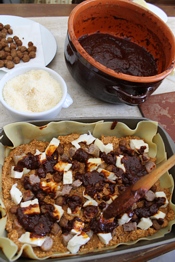 Neapolitan Carnivale Lasagna
Neapolitan Carnivale Lasagna Neapolitan Carnivale Lasagna
Neapolitan Carnivale LasagnaLasagna di Carnevale Napoletana
Serves 8
Rich ricotta lasagna layered with tiny meatballs, plus all sorts of optional extras like salami, sausage, and even sliced boiled eggs, this dish is the unofficial symbol of Carnival. Very lush and elaborate, this dish takes time and patience to prepare, beginning with the classic Neapolitan ragu, which must be cooked slowly over low heat. Locals call the method pippiare -- an onoatopedic word that hints at the sound of the sauce barely simmering, as one tiny bubble at a time pops.
I love the instructions the Neapolitans give to let the lasagna "rest and reflect," s'add a ripusà, for half an hour before serving. All the layers settle and you end up with gorgeous slices!
Ragu:
Olive oil
3/4 pound boneless pork loin, cut into 3 large chunks
4 lean pork ribs
2 sweet sausages
1 yellow onion, minced
1 cup red wine, preferably from the Alianico grape, a specialty of Campania
1 (28-ounce) container strained tomatoes, such as Pomi or Alice Nero brands
1 6-ounce can tomato paste
4 to 5 large fresh basil leaves
Salt
Meatballs:
2 slices white sandwich bread, crusts removed
1/2 pound ground beef or pork
1 egg
2 heaping tablespoons grated Parmesan cheese
Salt and black pepper
Peanut or sunflower oil
To assemble:
1½ pounds ricotta cheese
8 to 10 basil leaves, shredded
1 pound flat (non-curly) lasagna sheets, preferrably Felicetti brand
About 1 cup grated Parmesan cheese, divided
3/4 pound mozzarella, cut into small cubes
3 thin sausage links, cooked, optional
1/2 pound thinly sliced salami, any type, optional
3 hard-boiled eggs, sliced, optional
For the Ragu:
Heat 2 tablespoons of olive oil in a large saucepan over medium heat. Add the pork, ribs and sausages and brown on all sides. Add the onion and sauté 5 minutes, then add 1/4 cup wine, reduce the heat to very low, cover and simmer until the wine is absorbed, about 40 minutes. Add another 1/4 cup of wine and let absorb, and repeat, adding ¼ cup of wine every 40 minutes or so until all the wine is absorbed and the meat tender, about 2 hours. Add the strained tomatoes,,tomato paste and 4 or 5 large basil leaves. Season to taste with salt and pepper. Simmer on very low heat, covered, for 2 more hours, stirring occasionally and adding hot of water if needed. When done, remove the meats to serve separately.
For the Meatballs:
About an hour before the sauce is finished, wet the bread with a little water, squeeze out excess and and put in a bowl with the beef or pork, egg, Parmesan, and salt and pepper to taste. Mix until combined. Form tiny hazelnut sized meatballs, about 1/2 inch in diameter.
Heat 2 inches of oil in a small saucepan over medium high heat. Add the meatballs, a few at a time, and fry until golden, about 1 minute. Drain on a paper towel lined plate.
To assemble:
Preheat the oven to 320 F/160 C.
Mix the ricotta with 1 cup of the ragu and the shredded basil leaves.
Cook the lasagna sheets in boiling, salted water until al dente. Drain and spread onto clean cotton dishcloths to cool and keep them from sticking.
To assemble: Spread 1/2 inch of ragu on the bottom of a deep sided 14-inch lasagna baking pan and top with a layer of lasagna. Top with half of the ricotta mixture placed in dollops, and scatter over that half of the meatballs and half the sausage, salami or eggs, if using. Top with half the mozzarella, generous dollops of ragu and 3 heaping tablespoons of grated Parmesan. Layer #2: Add another layer of lasagna, top with the remaining ricotta mixture placed in dollops and scatter on the remaining meatballs. Spread on a few ladlefuls of ragu, the remaining mozzarella and remaining sausage, salami or eggs, if using. Top with 3 heaping tablespoons of grated Parmesan and finish with a final layer of lasagna. Generously spread with ragu and top with 3 heaping tablespoons Parmesan cheese.
Bake for about 1 hour, finishing on high so the top browns at the edges. Let rest for 30 minutes before slicing. Serve topped with more ragu and grated cheese on the side.
Serve the pork loin, ribs and sausages from the ragu as a second course, that is, if anyone is still hungry.